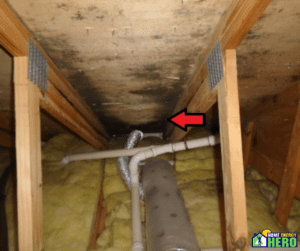
It Might Be a Problem!
Bath fans play a crucial role in maintaining indoor air quality by removing excess moisture, but when they’re not vented properly, they can do more harm than good. During a recent home energy audit, we discovered a bath fan vented near the eaves, but instead of sending moisture outside, it was pushing humid air into the attic—creating the perfect environment for mold growth. Mold isn’t just a home issue; it’s a health issue, affecting air quality and potentially leading to respiratory problems. Where is your bath fan venting? If you’re unsure, it’s time to get an audit before moisture damage becomes a costly problem!
The Importance of Proper Bath Fan Venting
If your bath fan isn’t venting properly, moisture can build up in areas like walls, ceilings, and attics, leading to potential mold and mildew problems. Bath fans are essential for directing this moisture outside, preventing hidden damage that can go unnoticed until it’s too late. When ventilation is inadequate, it can cause issues like wood rot, compromised insulation, and other costly repairs. Ensuring proper venting not only helps maintain your home but also protects your health by preventing mold growth in hard-to-see places.
Where Should a Bath Fan Vent?
The best practice for bath fan venting is to direct the moisture outside the home, not into an attic or crawl space. Where is your bath fan venting? Common vent locations include through the roof (the most recommended option), through the sidewall of the home, or through the soffit (though this can sometimes cause issues—more on that below!). Proper venting ensures that moisture is expelled correctly, reducing the risk of mold and structural damage in hidden areas of your home.
Common Bath Fan Venting Mistakes (And Their Consequences!)
Improper bath fan venting can lead to significant issues in your home. Venting into the attic can cause mold growth, wood rot, and insulation damage as moisture gets trapped in hidden spaces. Venting near the soffit/eaves is another common mistake, as moisture can be pulled back into the attic instead of being properly expelled. Using too long or improperly sealed ducting reduces efficiency and leads to increased condensation, while the absence of a backdraft damper allows cold air to enter, driving up energy costs. These mistakes not only affect your home’s comfort but can also lead to costly repairs down the line.
Proper Ducting for Bath Fans
When it comes to bath fan ducting, smooth metal ducting is the recommended material, as it’s more durable and efficient than flexible plastic. The best duct routing minimizes bends and length to ensure moisture flows easily outside, preventing condensation buildup and reducing the risk of leaks. Additionally, insulating the duct is required for preventing condensation inside the duct, which can lead to water damage and mold growth if left unchecked. Proper ducting is key to maximizing the efficiency of your bath fan and ensuring moisture is properly expelled from your home.

Conclusion
Proper bath fan venting is crucial for preventing moisture buildup, mold growth, and long-term damage to your home. By ensuring your bath fan is vented correctly, you protect your home’s structure, improve air quality, and avoid costly repairs down the road. If you’re unsure about your current setup, it’s a good idea to check your venting or schedule an energy audit to ensure your home is mold-free and moisture-free.
Book an audit today to identify potential issues before they become major problems!

